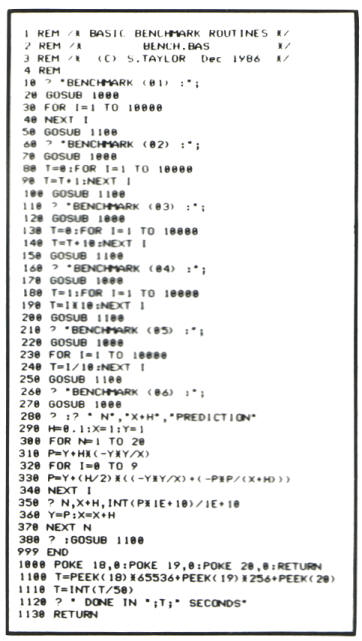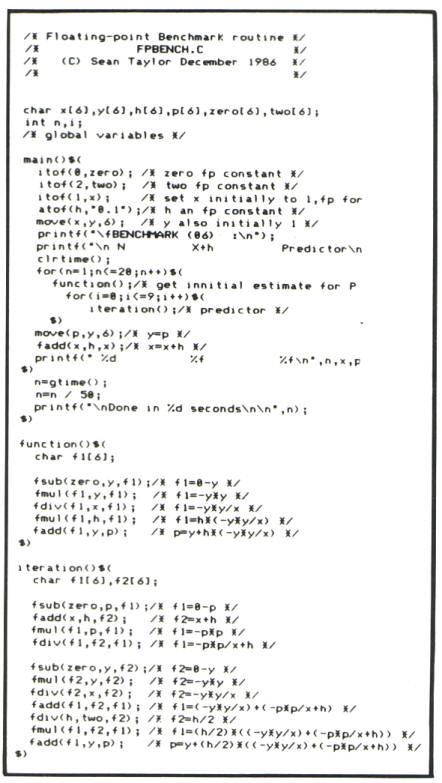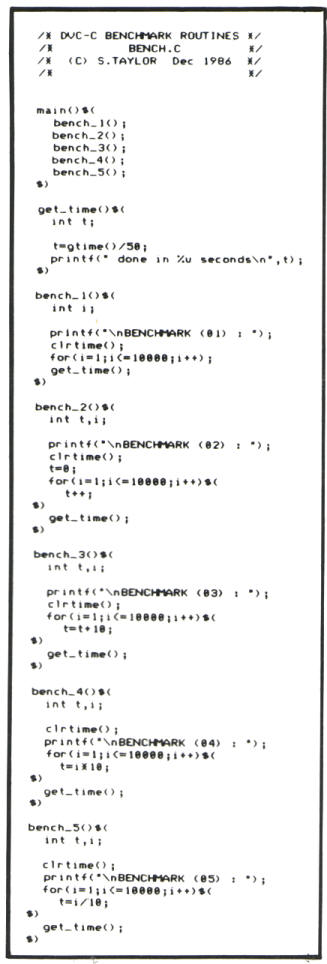Since the launch of the ST, the fashionable language for use on
these Atari computers has been 'C'. Languages of any description for
the 8-bit machines however are, to say the least, hard to come by
(ACTION and BASIC XL aside), however now the 8-bit user may sample
the delights of this 'trendy' language with the DVC/65 'C'
compiler.
PROGRAM OVERVIEW
The language comes supplied on a single double
sided diskette, with a yellow and blue typeset booklet explaining
the less standard functions of the system. On inspecting the booklet
provided, it will become apparent that it is intended to be used as
an appendix to the book 'The C Programming Language' by Kernighan
and Ritchie. As might be expected the language implemented is a 'small' C, however the system does provide the facility to
interface with 'ACTION!' and Assembler (namely MAC/65). The program
diskette contains a variety of utilities and example programs, many
of which may be run directly, although others require compiling
first. On booting the diskette, you are greeted with a disk
directory which loads and runs as an AUTORUN file. You are prompted
for a program name and entering one of the demo names illustrates
straight away the speed of the language. Before proceeding further
the system disk should be backed up.
THE DOCUMENTATION
The documentation would appear to be the weakest
point of the package. The 57 page booklet is adequate, but if you
are new to C then it can be confusing. It would have been nice to
have been provided with a complete function and word index, however
the booklet does describe the functions it includes quite fully. The
booklet may be considered as having three main sections, the first
applying to the DVC compiler itself, the second to the use of the
DVC system with the ACTION! cartridge, and the third with the use of
the MAC/65 assembler. Again the text is direct and to the point, but
the subjects are covered a little too briefly. The booklet does not
pretend to be a tutorial, nor would I expect one, but I would have
liked to have seen a few examples at least.
USING THE SYSTEM
DVC has some annoying anomalies, for example you
cannot assign a value within a declaration, e.g. the expression
int
val = 10
would have to be given as
int val;
val = 10
not crippling but annoying when errors arise at compile time.
Probably of more interest, floating-point arithmetic is supported,
but strangely floating-point numbers must be considered as character
strings. If you are used to manipulating floating-point numbers in
assembler using the operating system routines, then this may not
seem so strange.
As an example, the expression
float number;
would have to be replaced by
char number[6];
This illustrates that several data type structures are not
supported. however some very useful utilities are provided for
program development.
The most essential is the editor. This is smart and easy to use with
all commands readily available on a menu screen by pressing '?' and
allowing single key entry for loading, renumbering, disk cataloguing
etc. Further prompts are provided as required by the program editor.
All programs are written using line numbers, these being more for
the benefit of the program editor than the programmer. Some very
useful keywords have been provided using a [CONTROL] [KEY]
combination, for example pressing [CONTROL] and [P] will display printf(". These key combinations make program entry quicker and more
pleasant.
The system supports a very powerful command line editor allowing
programs to be loaded and arguments to be passed to them. For
example:
D1:CC PROG LINK RUN
will load the compiler (CC.COM) which will then compile the program PROG.C LINK.COM
will create the relevant .LNK and..COM files and
finally the program PROG.COM, created by LINK.COM, will be run.
All program names are normalised, that is to say that only the name
need be specified, the DVC system will take care of the name
extender and drive number. The system uses a custom DOS. which is
compatible with DOS 2.Os and DOS 2.5, however system files cannot be
run without the DVC system DOS being present. The DVC DOS will only
support single or double density disk format, the dual density mode
offered by the 1050 is not supported.
THE DISK FILES
The diskette comes with a large selection of
utility files, games and functions. The main COM files are provided
on side A, including the system DOS. The system expects to find five
forms of file name extender. These being .C to specify a text file,.
.CCC to specify a compiled text file, .LNK to specify a link file, .OBJ
for an object file from an assembler and .COM for a file that may be
readily executed.
Several useful utilities are provided, allowing the creation of
AUTORUN.SYS files, customising of DVC-DOS, reconfiguring the disk
set-up, provision of a ramdisk for the XE and the 800XL using a
Mosaic Ramboard. For most of the utilities and games provided the source code is readily available, allowing the
utilities to be studied, altered and re-compiled. This freedom with
the source files allows the author's programs to be studied and
listed and also shows how to overcome some of the language
anomalies.
Some very useful and amazingly fast graphics utilities have been
included. They are best illustrated by running the graphic demo
provided on the disk. These provide very fast drawing, plotting and
circle drawing in graphics 8, running up to eight times faster than
the normal functions also provided.
The system provides a very comprehensive set of functions for use
with CIO. These hook directly to the operating system ROM and
provide the versatility found when using these routines at machine
code level.
HOW FAST IS DVC-'C'
A series of short benchmark routines were used, to
compare DVC with Basic and GO-FORTH from SECS. In all cases the
internal clock registers of the 800XL were used to produce the times
shown.
| BENCHMARK |
BASIC |
DVC-C |
FORTH |
| 1 |
25 |
8 |
5 |
| 2 |
56 |
14 |
6 |
| 3 |
60 |
14 |
7 |
| 4 |
103 |
19 |
13 |
| 5 |
128 |
21 |
38 |
| 6 |
14 |
13 |
- |
TIME/seconds
From these times it is apparent that 'C' provides
a speed increase of upwards of 50% over basic. However, as might be
expected, the short floating point routines do not show any marked
improvement. For calculations involving numerous iterations then
some improvement would be expected. The floating-point benchmark
also illustrates how these functions have been implemented in the
DVC system.
DIFFERENCES AND UNSUPPORTED FEATURES
DVC shows several features that are either
different from Standard 'C' or not supported at all. These may be
listed as follows.
1) Structures and unions are not supported.
2) Multidimensional arrays and pointer arrays are not supported.
3) Full Floating-point arithmetic is not supported.
4) Variable types int, char, extern only are supported.
5) Macro
expansions in údefines and assignments within declarations are not
supported.
6) Constant evaluation is performed at compile time. No
order of precedence is given to arithmetic operators, all expressions are evaluated from right to left.
7) Variables may not be declared within a statement block.
8) All functions return a two byte word.
9) The braces, due to the lack of the graphic on the keyboard, are
replaced with $( and $).
These are probably the more evident differences.
However for the most part they may be programmed around.
CONCLUSIONS
The DVC-'C' system does provide very good value
for money. The sheer number of utilities and example programs
provided on both sides of the disk support this. Early versions of
the disk contain a corrupted LIFE.COM file, which will not load or
run, however this may be corrected by copying the relevant (LIFE.CCC,
LIFE.OBJ and LIFE.LNK) files to a work disk and running the file
linker.
The one major criticism, is the strange way in which floating point
arithmetic has been implemented. It poses the question, "If you went
this far, why didn't you do it properly?". Also of relevance
multidimensional arrays and pointer arrays are not supported.
Quibbles aside, the system is pleasant and easy to use. More
importantly it does support the claims made by all those trendies,
the language provides structured, easily read source code, and even
more to the point, if you understand Basic then you should pick up 'C' in no time.
Overall this package should be wholly recommended. Buy it you and
you won't be disappointed.
DVC/65 is available from Mikes Computer Store, 292
London Road, Westcliff-on-sea, Essex SS0 7JJ

Figure 1 - BASIC Benchmarks

Figure 2 - C equivalents

Figure 3 - Floating Point routines in C
top